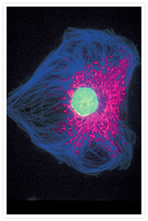Search Thermo Fisher Scientific
Exponentially growing promyelocytic leukemia (HL60) cells. Hoechst 33258 and ChromaTide BODIPY FL-14-dUTP.
Detection of BrdU-incorporating cells using the SBIP (Strand Breaks Induced by Photolysis) technique. Exponentially growing human promyelocytic leukemia (HL60) cells were incubated with 20 µM BrdU (B23151) for 40 minutes and then with 20 µg/mL Hoechst 33258 (H1398, H3569, H21491) in the presence of 2% DMSO for an additional 20 minutes. After this incubation, the cells were exposed to 300 nm UV light for 5 minutes to selectively photolyze DNA that contained the incorporated BrdU, and then fixed in 70% ethanol. Subsequent incubation of the permeabilized cells with the ChromaTide BODIPY FL-14-dUTP (C7614) in the presence of exogenous terminal deoxynucleotidyl transferase resulted in incorporation of the fluorophore into DNA strand breaks, thereby labeling the S-phase cells. The DNA was counterstained with the red-fluorescent nucleic acid stain propidium iodide (P1304MP, P3566, P21493); therefore, the BODIPY FL dye–labeled DNA appears yellow. The image was contributed by Zbigniew Darzynkiewicz, Cancer Research Institute, New York Medical College.

Related Products
Related Images
BPAE cells fixed and permeabilized using the Image-iT® Fixation/Permeabilization Kit. Go ›

BPAE cells fixed and permeabilized using the Image-iT® Fixation/Permeabilization Kit. Go ›

1% Agarose gel containing 16S and 23S ribosomal RNA (rRNA). SYBR® Green II RNA gel stain. Go ›

Bovine pulmonary artery endothelial cells (BPAEC). MitoTracker® Red CMXRos, SYTOX® Green nucleic acid stain, biotin-XX goat anti–mouse IgG antibody and Cascade Blue® NeutrAvidin biotin-binding protein. Go ›
